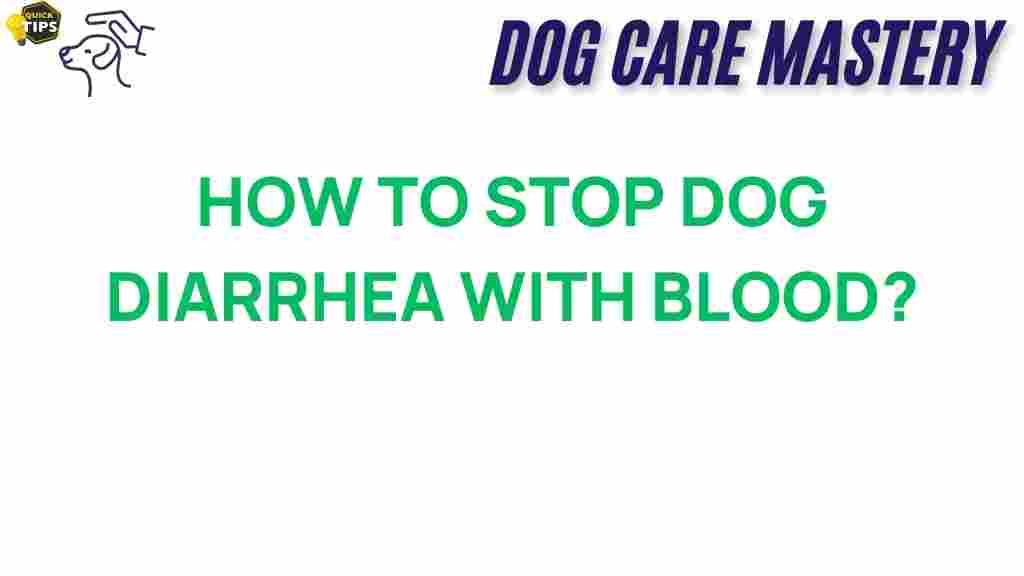Unraveling the Mystery: How to Stop Dog Diarrhea
Dog diarrhea can be a distressing issue for both pets and their owners. When you notice blood in your dog’s stool, the situation becomes even more alarming. This article aims to provide a comprehensive guide on how to address dog diarrhea, particularly when it involves blood. We will explore the causes, symptoms, and effective treatments, ensuring you have the knowledge to help your furry friend recover.
Understanding Dog Diarrhea
Before diving into solutions, it’s essential to understand what dog diarrhea is and what it means. Diarrhea is characterized by loose or watery stools, often accompanied by an increase in frequency. When it presents with blood, it can be indicative of more serious underlying issues. Here are some common causes of dog diarrhea:
- Dietary indiscretion: Dogs are notorious for eating things they shouldn’t, leading to gastrointestinal upset.
- Infections: Bacterial, viral, or parasitic infections can irritate the intestines.
- Food allergies: Some dogs may develop allergies or intolerances to specific ingredients.
- Inflammatory bowel disease: Chronic inflammation can lead to persistent diarrhea.
- Stress: Changes in routine or environment can affect a dog’s digestive health.
Identifying Symptoms
Recognizing the symptoms of dog diarrhea is crucial for timely intervention. Besides loose stools with blood, look out for:
- Frequent trips to the bathroom
- Straining or discomfort while trying to defecate
- Vomiting
- Lethargy
- Loss of appetite
If your dog exhibits these symptoms, especially with blood present, it’s important to act quickly.
Immediate Actions to Take
When faced with dog diarrhea, especially with blood, the first step is to assess the situation. Here’s a step-by-step process to follow:
Step 1: Monitor Your Dog
Keep a close eye on your dog’s condition. Note the frequency and consistency of stool, any additional symptoms like vomiting or lethargy, and how long the diarrhea has been occurring.
Step 2: Withhold Food Temporarily
For 12 to 24 hours, consider withholding food to give your dog’s digestive system a chance to recover. However, ensure they have constant access to fresh water to prevent dehydration.
Step 3: Introduce a Bland Diet
After the fasting period, gradually introduce a bland diet. Options include:
- Boiled chicken (no skin or bones)
- Plain white rice
- Plain pumpkin (not the spiced pie filling)
- Boiled potatoes (without butter or seasoning)
Start with small portions and increase as your dog’s condition improves.
Step 4: Reintroduce Regular Diet
Once your dog’s stool returns to normal, slowly reintroduce their regular food over a few days. This will help prevent the digestive system from becoming overwhelmed.
Step 5: Hydration is Key
Ensure your dog stays hydrated throughout the process. Consider offering an electrolyte solution designed for pets, which can help replenish lost nutrients.
When to Seek Veterinary Help
While many cases of dog diarrhea resolve with home treatment, there are specific situations that necessitate veterinary intervention:
- If diarrhea persists for more than 24 hours
- If your dog is very young, elderly, or has pre-existing health conditions
- If there are additional symptoms like severe vomiting, dehydration, or lethargy
- If the blood in the stool is abundant or appears dark and tarry
In these cases, it’s essential to consult a veterinarian who can diagnose the underlying issue and recommend appropriate treatments.
Troubleshooting Common Issues
If you’ve tried the above steps but your dog’s diarrhea persists, consider the following troubleshooting tips:
Check for Dietary Changes
Have you changed your dog’s food recently? Switching to a new brand or flavor can upset their stomach. Always transition gradually over a week.
Consider Allergies or Intolerances
Food allergies may require further investigation. If you suspect this could be the case, consult a vet for allergy testing or a specialized elimination diet.
Evaluate Stress Factors
Changes in your dog’s environment, such as moving to a new home or introducing new pets, can lead to stress-induced diarrhea. Maintaining a calm and stable environment is crucial.
Look for Parasites
Parasites like worms can cause gastrointestinal issues. A vet can perform a fecal test to determine if this is the cause.
Preventive Measures
<pTaking steps to prevent dog diarrhea is just as important as treating it. Here are some tips:
- Maintain a consistent diet: Avoid sudden changes to your dog’s food.
- Monitor treats: Make sure treats are appropriate and not contributing to digestive upset.
- Regular vet check-ups: Annual health examinations can catch potential issues early.
- Keep food and waste areas clean: This can prevent infections and parasites.
- Limit table scraps: Human food can be too rich for dogs and lead to digestive issues.
Conclusion
Dog diarrhea, particularly when it involves blood, can be a concerning sign of underlying health issues. Acting promptly and following the steps outlined in this guide can help manage the situation effectively. Remember that while many cases can be treated at home, consulting a veterinarian is crucial if symptoms persist or worsen. Your dog’s health and comfort are paramount, so take the necessary steps to ensure their well-being.
For more information on dog health and wellness, check out this comprehensive guide. If you suspect your dog has dietary issues, consider visiting an expert’s site for further advice here.
This article is in the category Health and created by dogcaremastery Team
